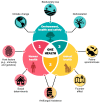Current Progress on Epidemiology, Diagnosis, and Treatment of Sporotrichosis and Their Future Trends
- PMID: 35893145
- PMCID: PMC9331723
- DOI: 10.3390/jof8080776
Current Progress on Epidemiology, Diagnosis, and Treatment of Sporotrichosis and Their Future Trends
Abstract
Sporotrichosis, a human and animal disease caused by Sporothrix species, is the most important implantation mycosis worldwide. Sporothrix taxonomy has improved in recent years, allowing important advances in diagnosis, epidemiology, and treatment. Molecular epidemiology reveals that S. brasiliensis remains highly prevalent during the cat-transmitted sporotrichosis outbreaks in South America and that the spread of S. brasiliensis occurs through founder effects. Sporothrix globosa and S. schenckii are cosmopolitan on the move, causing major sapronoses in Asia and the Americas, respectively. In this emerging scenario, one-health approaches are required to develop a creative, effective, and sustainable response to tackle the spread of sporotrichosis. In the 21st century, it has become vital to speciate Sporothrix, and PCR is the main pillar of molecular diagnosis, aiming at the detection of the pathogen DNA from clinical samples through multiplex assays, whose sensitivity reaches remarkably three copies of the target. The treatment of sporotrichosis can be challenging, especially after the emergence of resistance to azoles and polyenes. Alternative drugs arising from discoveries or repositioning have entered the radar of basic research over the last decade and point to several molecules with antifungal potential, especially the hydrazone derivatives with great in vitro and in vivo activities. There are many promising developments for the near future, and in this review, we discuss how these trends can be applied to the Sporothrix-sporotrichosis system to mitigate the advance of an emerging and re-emerging disease.
Keywords: Sporothrix brasiliensis; Sporothrix globosa; Sporothrix schenckii; antifungal; diagnosis; epidemiology; implantation mycosis; sporotrichosis; subcutaneous mycosis; treatment.
Conflict of interest statement
The authors declare no conflict of interest. The funders had no role in the design of the study; in the collection, analyses, or interpretation of data; in the writing of the manuscript, or in the decision to publish the results.
Figures







References
Publication types
Grants and funding
- 2017/27265-5/São Paulo Research Foundation
- E-26/202.513/2019/Fundação Carlos Chagas Filho de Amparo à Pesquisa do Estado do Rio de Janeiro
- E-26/210.873/2019/Fundação Carlos Chagas Filho de Amparo à Pesquisa do Estado do Rio de Janeiro
- CNPq 429594/2018-6/National Council for Scientific and Technological Development
- 88887.177846/2018-00/Coordenação de Aperfeicoamento de Pessoal de Nível Superior
LinkOut - more resources
Full Text Sources
Miscellaneous

